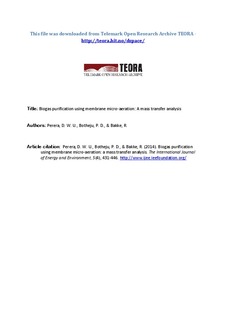Biogas purification using membrane micro-aeration: A mass transfer analysis
Journal article, Peer reviewed
Published version
Permanent lenke
http://hdl.handle.net/11250/2438561Utgivelsesdato
2014Metadata
Vis full innførselSamlinger
Originalversjon
Perera, D. W. U., Botheju, P. D., & Bakke, R. (2014). Biogas purification using membrane micro-aeration: a mass transfer analysis. The International Journal of Energy and Environment, 5(4), 431-446.Sammendrag
When sulfur containing organic feedstocks undergo anaerobic digestion, sulfides are formed due to the biological activities of sulfur reducing bacteria. Presence of hydrogen sulfide (H2S) negatively affects the usage of biogas and needs to be reduced to levels that depend on the intended biogas application. Conversion of sulfide to its oxidized forms can be carried out by aerobic chemolithotrophic bacteria consuming oxygen as the electron acceptor. Membrane micro-aeration is a recently developed reliable method of safely supplying oxygen into anaerobic digesters. In this study, mass transfer models are developed to represent diffusion and back diffusion of gases through tubular polydimethylsiloxane (PDMS) membranes. The models are utilized to determine the required membrane area and length in order to supply the stoichiometric amount of oxygen for biologically oxidizing a given amount of sulfide feed into elemental sulfur. Penetration of oxygen and nitrogen into the digester and transfer of methane, carbon dioxide and hydrogen sulfide back into the membrane tube are analyzed using these mass transfer models. Circulating air or aerated water inside the membrane tube is considered as two alternatives for supplying micro-aeration to the digester. Literature digester performance and sulfide data are used for example calculations. The required membrane length depends on circulating water flow rates and dissolved oxygen concentrations when water is used inside the membrane. A considerable fraction of CO2 can also be removed from the biogas in this case. Circulating air inside the membrane is, however, more promising solution as it requires much less membrane area and thereby also causes insignificant methane loss. The proposed membrane micro-aeration technique cuts N2 biogas dilution in half compared to direct air purging for in-situ sulfide oxidation.

